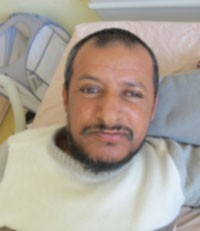Fael Salim Khuidam Al-Zari - Sequelae of spinal cord injury (Oman) Posted on April 12,2012
Name: Fael Salim Khuidam Al-Zari 
Sex: Male
Country: Oman
Age: 51
Diagnosis: Sequelae of spinal cord injury
Admission Date: March 12, 2012
Days Admitted to Hospital: 27
Fael was involved in a car accident in April 2011. As a result of the accident he lost control of the voluntary muscle movements in the arms and legs, he also lost sensation and developed breathing difficulties. At the local hospital it was revealed that there was a neck injury between the cervical vertebrae segments 4 and 5. Fael underwent surgery for the neck injury and he a tracheotomy procedure to assist his breathing. After the surgery, Fael was still unable to move his arms or legs. One month later, the respiration had stabilized and Fael began participating in a physical rehabilitation training program. About a month before coming to our medical center for treatment, there was slight ability of the legs to do the adduction movement and to extend straight out. At this time, Fael could raise his arms but could not close his fingers and grasp objects. There was a reduced sense of sensation below the chest. The muscle tone in both legs was slightly high and there were obvious spasms. During this time, Fael was completely unable to take care of himself.
Admission PE:
Bp: 122/80mmHg; Hr: 52/min. Br: 18/min. The skin and mucosa were intact, with no yellow stains or hemorrhagic spots. The thorax was symmetrical. The respiratory sounds in both lungs were clear, with no dry or moist rales. The heart rate was regular, with no obvious murmur in the auscultation valve area. The abdomen was distended. The abdominal muscles were tight. The doctors were not satisfied with the palpation. The liver and spleen were not palpable. There was mild muscle atrophy in both palmar interossei. There was a tracheotomy scar on the neck.
Nervous System Examination:
Fael was alert and his speech was fluent. He was in good spirits. His memory, calculation abilities and orientation were normal. Both pupils were equal in size and round, the diameter was 3.0mms. Both eyeballs could move freely and the pupils reacted normally to light stimulus. The convergence ability of the left eye was poor. The forehead wrinkle pattern was symmetrical. The tongue was centered in the oral cavity and the teeth were shown without deflection. The neck had flexible movement. The shrugging strength of the shoulders was weak. The adduction strength of the right upper limb��s proximal-end was level 4 -, and the abduction strength was level 3. The adduction strength of the left upper limb's proximal-end was level 4, and the abduction strength was level 3-. Both wrists and the fingers on both hands had difficulty with movement. The muscle strength of both lower limbs was level 1+. Both lower limbs could stretch and flex passively. The muscle tone of both upper limbs and both lower limbs was slightly high. The bilateral patellar tendon reflex was normal. The tendon reflex of both lower limbs was active. The myoclonus in all four limbs was obvious and the lower limbs were more severe. The bilateral abdominal reflexes were able to be slightly elicited. The temperature sensation between the cervical vertebrae segments 7 and 8 and below the thoracic vertebrae segment 6 was diminished. The shallow sensation had noticeably diminished. The seismesthesia between the hip joints and the knee joints was weaker than normal. The bilateral Hoffmann's sign was positive. The bilateral palm jaw reflex was negative. The sucking reflex was negative. The bilateral Babinski's sign was not elicited. Fael was unable to finish the rapid rotation test, the heel-knee-shin test or the finger-to-nose-test.
Treatment:
We initially gave Fael a complete examination and he was diagnosed with sequelae of spinal cord injury. Then we proceeded with the nerve nutrition, and improved the blood circulation in order to increase the blood supply to the damaged neurons. This was combined with daily physical rehabilitation training.
Post-treatment:
The adduction strength of both upper limbs' proximal-end reached level 4+ and the abduction strength reached level 3. The patient can stretch both lower limbs after bending the knees passively. Both lower limbs have a sweeping motion and the muscle strength reached level 2. There is enhanced deep and shallow sensation below the damage plane. The muscle tone and myoclonus in all four limbs has been alleviated. Both thumbs and the joints of the middle finger of both hands have more flexible movements. Both shoulder joints have more flexible mobility and have better shrugging strength.
Fael's family member email to us:
2012-05-02
Hi liza,
how are you. fael is better, general health is good vital signs stable, aftere discharge, his upper limbs is improving, he can move his hand.
fael salim alzarai
See fael's vedio
(Download the Windows Media Player Firefox Plugin if you are using Firefox browser.
To know more,Please read Using the Windows Media Player plugin with Firefox.)
